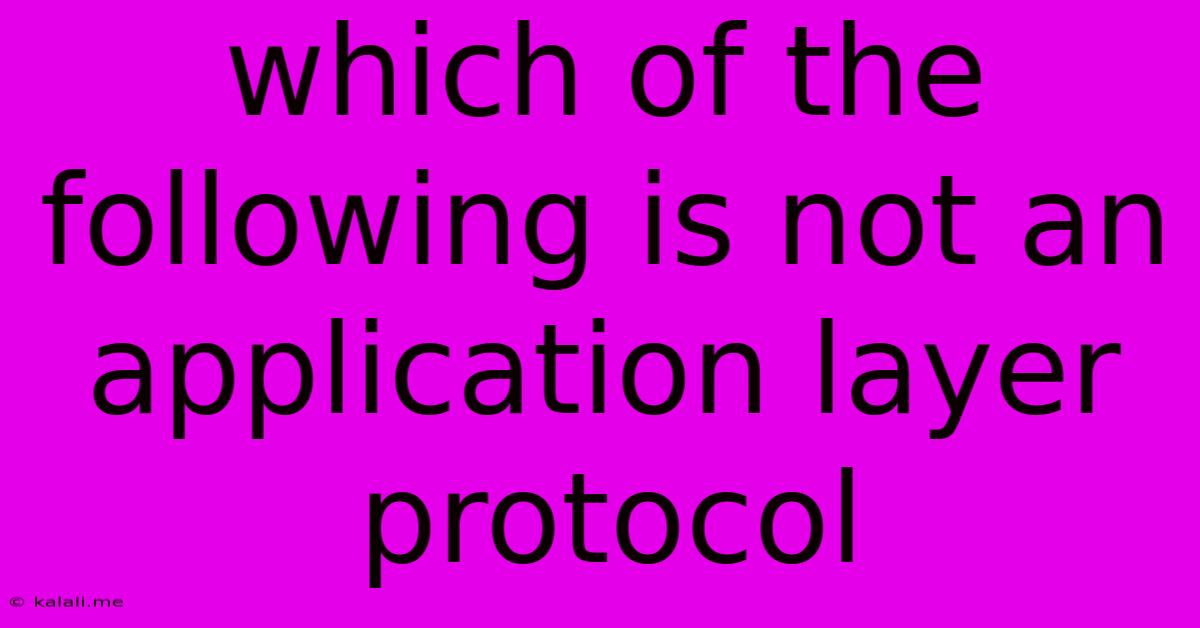Which Of The Following Is Not An Application Layer Protocol
Kalali
Jun 14, 2025 · 3 min read

Table of Contents
Which of the Following is NOT an Application Layer Protocol? Understanding Network Layers
This article will explore the different layers of the network model, focusing specifically on the application layer and identifying protocols that don't belong there. Understanding this distinction is crucial for anyone working with networks, computer systems, or cybersecurity. We'll delve into the function of the application layer and clarify the roles of various protocols.
The application layer is the highest layer in the TCP/IP model (and the OSI model, though with some differences in specific protocol placement). It's responsible for providing network services to applications. This means it handles the actual data the user interacts with – things like emails, web pages, and file transfers. Protocols at this layer ensure that data is formatted correctly for the application to understand and that the communication between applications is seamless.
Common Application Layer Protocols:
Several protocols are commonly associated with the application layer, including:
- HTTP (Hypertext Transfer Protocol): The foundation of the World Wide Web, used for transferring web pages and other web resources.
- HTTPS (Hypertext Transfer Protocol Secure): A secure version of HTTP, utilizing encryption to protect data during transmission.
- FTP (File Transfer Protocol): Used for transferring files between computers.
- SMTP (Simple Mail Transfer Protocol): The protocol for sending emails.
- POP3 (Post Office Protocol version 3) and IMAP (Internet Message Access Protocol): Protocols for receiving emails.
- DNS (Domain Name System): Translates domain names (like
google.com) into IP addresses. While technically residing at the application layer, its functionality often overlaps with the transport layer. - SNMP (Simple Network Management Protocol): Used for managing network devices.
Protocols that are NOT typically considered Application Layer Protocols:
Several protocols operate at different layers of the network model. Identifying these is key to understanding network architecture. Examples include:
- IP (Internet Protocol): This is a core network layer protocol, responsible for addressing and routing packets across networks. It handles the delivery of data packets between different networks, not the specific application data.
- TCP (Transmission Control Protocol): A transport layer protocol that provides reliable, ordered, and error-checked delivery of data. It ensures that data arrives correctly, but doesn't deal with the specifics of the application data itself.
- UDP (User Datagram Protocol): Another transport layer protocol, offering a faster but less reliable data delivery mechanism compared to TCP. It prioritizes speed over guaranteed delivery.
Identifying the Incorrect Protocol:
When presented with a multiple-choice question asking which protocol is not an application layer protocol, carefully consider the function of each protocol. If the protocol is responsible for addressing, routing, or reliable data delivery (rather than application-specific data handling), it's likely not an application layer protocol.
In Conclusion:
Understanding the different layers of the network model and the protocols associated with each layer is critical for troubleshooting network issues, designing secure networks, and comprehending the underlying structure of the internet. By recognizing the unique functions of application layer protocols versus those at other layers, you can better appreciate the complexity and efficiency of modern network communication. Remember that while some protocols may have aspects that span multiple layers, their primary function dictates their layer classification.
Latest Posts
Latest Posts
-
Which Of The Following Is False Regarding Air Masses
Jun 15, 2025
-
Grasslands Of South America Are Called
Jun 15, 2025
-
Least Common Multiple Of 3 And 13
Jun 15, 2025
-
What Is The Factor Of 92
Jun 15, 2025
-
Gpa Requirements For University Of North Georgia
Jun 15, 2025
Related Post
Thank you for visiting our website which covers about Which Of The Following Is Not An Application Layer Protocol . We hope the information provided has been useful to you. Feel free to contact us if you have any questions or need further assistance. See you next time and don't miss to bookmark.